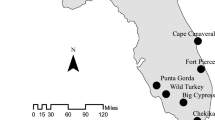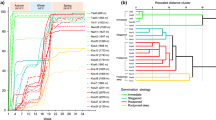Summary
Germination synchrony may facilitate damping-off epidemics by creating a high density of uniformly susceptible individuals. We tested the hypothesis that synchronous germination causes increased seed and seedling mortality from damping-off in two legume species attacked by the fungal pathogen, Pythium aphanidermatum. Glycine max exhibited rapid, synchronous germination compared to its progenitor, G. soja, and suffered greater mortality from both pre-and postemergent damping-off in controlled environment experiments. However, when mixed-aged populations of G. max were created experimentally by staggering planting times, a significant increase in damping-off mortality occurred. In G. soja, which typically has mixed-aged populations due to asynchronous germination, experimental populations with an even-aged distribution also suffered increased damping-off mortality. Hence, the relationship between population age structure and damping-off mortality was species-specific. We propose that species differences in the duration of individual seedling susceptibility to disbase interact with population age structure to control the cutcome of damping-off epidemics.
Similar content being viewed by others
References
Adams PB (1971) Pythium aphanidermatum oospore germination as affected by time, temperature, and pH. Phytopathology 61:1149–1150
Augspurger CK (1983) Offspring recruitment around tropical trees: changes in cohort distance with time. Oikos 40:189–196
Augspurger CK (1984) Seedling survival of tropical tree species: interactions of dispersal distance, light-gaps, and pathogens. Ecology 65:1705–1712
Augspurger CK, Kelly CK (1984) Pathogen mortality of tropical tree seedlings: experimental studies of the effects of dispersal distance, seedling density, and light conditions. Oecologia (Berlin) 61:211–217
Barton R (1958) Occurrence and establishment of Pythium in soils. Trans Brit Mycol Soc 41:207–222
Burdon JJ, Chilvers GA (1975a) A comparison between host density and inoculum density effects on the frequency of primary infection foci in Pythium-induced damping-off disease. Aust J Bot 23:899–904
Burdon JJ, Chilvers GA (1975b) Epidemiology of damping-off disease (Pythium irregulare) in relation to density of Lepidium sativum seedlings. Ann Appl Biol 81:135–143
Burdon JJ, Chilvers GA (1976) Epidemiology of Pythium-induced damping-off in mixed species seedlings stands. Ann Appl Biol 82:233–240
Carver MFF, Matthews S (1975) Respiratory measurements as indicators of field emergence ability in peas. Seed Sci and Tech 3:871–879
Chi CC, Hanson EW (1962) Interrelated effects of environment and age of alfalfa and red clover seedlings on susceptibility to Pythium debaryanum. Phytopathology 52:985–989
Cowling EB (1978) Agricultural and forest practices that favor epidemics. In: Horsfall JG, Cowling EB (eds) Plant disease vol II. How disease develops in populations. Academic Press, New York, pp 361–381
Fienberg SE (1978) The analysis of cross-classified categorical data. MIT Press, Cambridge, Massachusetts
Garrett SD (1970) Pathogenic root-infecting fungi. Cambridge University Press, Cambridge
Harper JL, Lovell PH, Moore KG (1970) The shapes and sizes of seeds. Ann Rev Ecol Syst 1:327–356
Hendrix FF Jr, Campbell WA (1973) Pythiums as plant pathogens. Ann Rev Phytopath 11:77–91
Kuan TL, Erwin DC (1980) Predisposition effect of water saturation of soil on Phytophthora root rot of alfalfa. Phytopathology 70:981–986
Leach LD (1947) Growth rates of host and pathogen as factors determining the severity of preemergence damping-off. J Agric Res 75:161–179
McCarter SM, Littrell RH (1970) Comparative pathogenicity of Pythium aphanidermatum and Pythium myriotylum to twelve plant species and intraspecific variation in virulence. Phytopathology 60:264–268
Middleton JT (1943) The taxonomy, host range and geographic distribution of the genus Pythium. Mem Torrey Bot Club 20:1–171
Morgan FL, Hartwig EE (1964) Pythium aphanidermatum, a virulent soybean pathogen (abstract). Phytopathology 54:901
Populer C (1978) Changes in host susceptibility with time. In: Horsfall HG, Cowling EB (eds) Plant disease vol. II. How disease develops in populations. Academic Press, New York, pp 239–262
Ride JP (1983) Cell walls and other structural barriers in defense. In: Callow JA (ed) Biochemical plant pathology. John Wiley and Sons, New York, pp 215–236
Schmidt RA (1978) Diseases in forest ecosystems: the importance of functional diversity. In: Horsfall JG, Cowling EB (eds) Plant disease vol II. How disease develops in populations. Academic Press, New York, pp 287–315
Sinclair JA (ed) (1982) Compendium of soybean diseases. 2nd edition. American Phytopathology Society, St. Paul, Minnesota
Stanghellini ME (1974) Spore germination, growth and survival of Pythium in soil. Amer Phytopathol Soc Proc 1:211–214
Thomson TB, Athow KL, Laviolette FA (1971) The effect of temperature on the pathogenicity of Pythium aphanidermatum, P. debaryanum and P. ultimum on soybean. Phytopathology 61:933–935
Wallace HR (1978) Dispersal in time and space: soil pathogens. In: Horsfall JE, Cowling EB (eds) Plant disease vol. II. How disease develops in populations. Academic Press, New York, pp 181–202
Wilde SA, White DP (1939) Damping-off as a factor in the natural distribution of pine species. Phytopathology 29:367–369
Woodstock LW, Grabe DF (1967) Relationships between seed respiration during imbibition and subsequent seedling growth in Zea mays L. Plant Physiol 42:1071–1076
Author information
Authors and Affiliations
Rights and permissions
About this article
Cite this article
Neher, D.A., Augspurger, C.K. & Wilkinson, H.T. Influence of age structure of plant populations on damping-off epidemics. Oecologia 74, 419–424 (1987). https://doi.org/10.1007/BF00378939
Received:
Issue Date:
DOI: https://doi.org/10.1007/BF00378939




